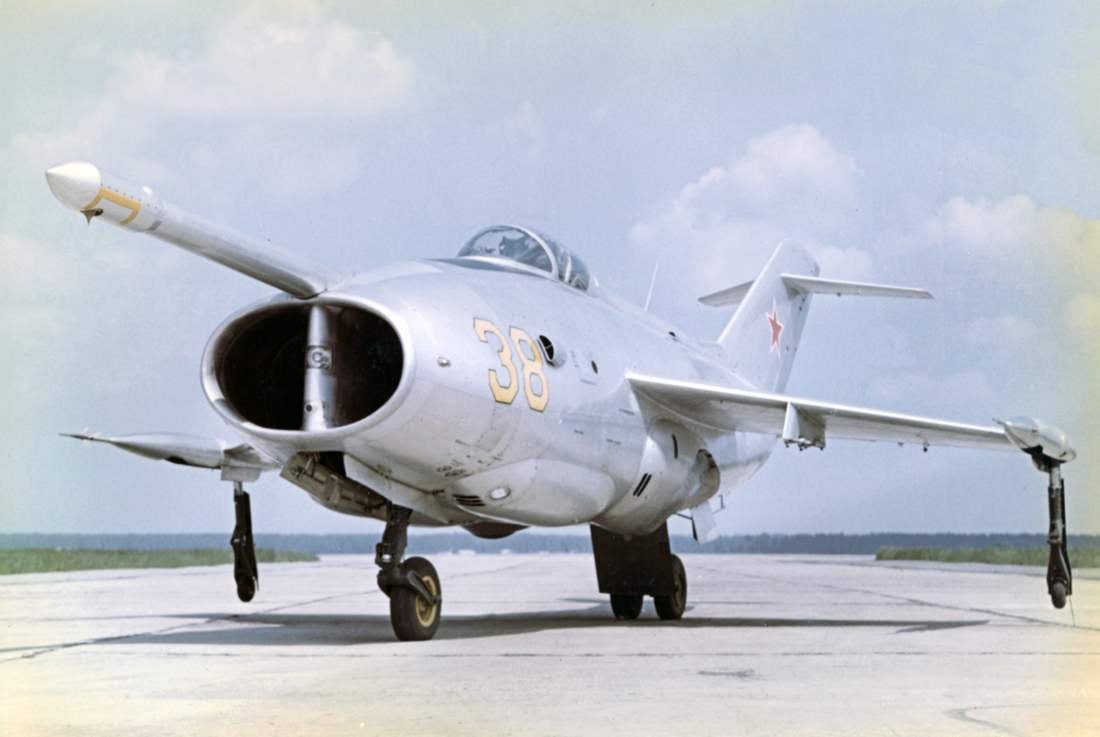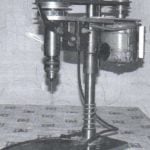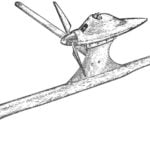 Vertical takeoff aircraft Yak-36. In 1960, Yakovlev made a proposal to the government to develop the aircraft vertical takeoff and landing (VTOL) Yak-104. The project involved the use of two lifting and propulsion uprated Р19-300 with a thrust of 1600 kgf with a rotary nozzle and one lifting Р19-300 traction 900 kg. It was expected that at flight weight of 2800 kg and the fuel capacity 600 kg VTOL aircraft can reach the speed of 550 km/h, climb to an altitude of 10 000 m and fly to a distance of 500 km.
Vertical takeoff aircraft Yak-36. In 1960, Yakovlev made a proposal to the government to develop the aircraft vertical takeoff and landing (VTOL) Yak-104. The project involved the use of two lifting and propulsion uprated Р19-300 with a thrust of 1600 kgf with a rotary nozzle and one lifting Р19-300 traction 900 kg. It was expected that at flight weight of 2800 kg and the fuel capacity 600 kg VTOL aircraft can reach the speed of 550 km/h, climb to an altitude of 10 000 m and fly to a distance of 500 km.
If not considered research for the Yak-28ВВ only in 1961, some options were considered VTOL. Among them was a single-seat fighter-bomber with two lift-cruise engines Р21М-300 and attack aircraft with two turbojet engines Р11В-300. The machine was equipped with a turbofan wing units that have operated the gas jets podyemnaya engines. This solution promised a significant gain in mass.
At the turn of 1950 — 1960s, supporters of this decision was most professionals the leading aviation powers, including the Soviet Union. It should be noted that the idea of using a fan to create a vertical thrust is not dead she is currently used on us fighter X-35B, but with a mechanically driven fan.
In February 1961 of the state Committee for aviation technology (GKAT) was sent to the Commission of the Presidium of the Council of Ministers of the USSR on military-industrial issues of the report where, in particular, stated:
“…To ensure the weight characteristics of the aircraft requires the specific weight of the engine is of the order of 0.08 — 0.1 kg/kg vs. 0.2 — 0.25 of the modern turbojet. The creation of such a light engine with satisfactory characteristics is very challenging. In search of this solution in OKB-300 (Tumansky), OKB-165 (Cradle) and Lame work was carried out (…) to establish a power plant consisting of a turbojet and a turbofan Assembly, malorechenskoe TRD only for takeoff and landing and engine combined with a rotary nozzle…
On the basis of the work performed and considering the great technical difficulties of creating a VTOL, as well as the complete lack of experience in this matter (…) Yakovlev and Tumansky make the following proposal:
In the first phase of the work was to create a single prototype aircraft such as fighter-bomber for the study of the piloting technique and combat use. The plane to build with two engines Р21М-300. Modernization of P21-300 will be carried out to increase traction and facilitate its… Engine will be equipped with a rotating nozzle.
The weight of the payload is 500 kg, the maximum speed at an altitude of 1000 m to 1100 km/h, range — 500 — 600 km. the Vertical thrust engines 2×5000 kgs in weight 2×950 kg.
Start date of test — IV square 1963
For the further development of work on VTOL to study the creation of an aircraft with large flight weight and with a more powerful power plant. The new power plant can be established on the basis of Р21М-300 equipment turbofan unit, which will provide a vertical thrust of up to 10,000 kgs. Aircraft such power plants can have a takeoff weight of 18 000 kg”.
To implement the adopted draft of the aircraft, first received the designation Yak-In (product “B”), and later the Yak-36. The draft government resolution on the development of a single-seat fighter-bomber with engines P21 M-300 thrust of 5000 kgf was prepared in April 1961 requirements for the aircraft provided for his flight with a maximum speed of 1100 -1200 km/h at 1000 m altitude Takeoff weight was not to exceed 9150 kg. the Rest of the design features corresponded to the above the report GKAT.
To accelerate the development of a system of stabilization and control of VTOL was proposed to conduct tests of the prototype of the fighter-bomber with two turbojet existing P21-300 thrust 4200 kgf, equip them with rotary nozzles. The government decision came on October 30, 1961
The future development of the Yak-36 was headed by SG Mordovin, who later became Deputy chief designer. Leading engineers in the car were O. A. Sidorov and V. N. Pavlov and flight tests — K. B. Bekibaev and V. N. Pots.
Actually designed experimental aircraft. A milestone on the way to it was created in 1958 in Lutoslawski Institute under the guidance of A. N. Rafaelyantsa research aircraft “Turbolet” with TRD AM-5. It was intended to explore modes of vertical takeoff and landing, as well as the efficiency of gas-jet rudders. The lead pilot of a “flying stand” was Yu. a. Garnaev, but no less impressive it was piloted by S. N. Anokhin, F. Burtsev and I. G. Zakharov. Of these, only Yu. a. Garnaev had to do with the Yak-36. In 1959, the OKB-26 was developed Turbolet “Sharp” with the engine R-25-26.
By this time in the UK have already flown a VTOL Harrier with one of lifting and sustainer turbojet engine and four rotating nozzles. Unlike Western counterparts, the domestic aircraft plane “” went on his way.
The purpose of the aircraft and the choice of the lifting and propulsion turbojet Р27В-300 g revolving nozzles led to the installation in the nose and tail parts of the fuselage jet rudders high thrust. One of them actually had to bring forward on a long rod, because their task was not only control of the plane under transient conditions, but the balancing apparatus to hover. The engines were placed in the nose of the car, and their nozzles in the area of the center of gravity. This decision, taken 15 years later after the first domestic jet fighters led to return to being transferred to the scheme.
A similar arrangement of the power plant led to the use bike chassis with a one-wheeled and two-wheeled rear bow supports. The wing supports were removed against the direction of flight in the fairings, while on the right installed a standard receiver air pressure (LDPE) with sensors of angles of attack and slip (DUAS). The design of the airframe was typical for airplanes of those years: semi-monocoque fuselage and longerone wing flaps.


Experimental aircraft vertical takeoff and landing Yak-36:
1 — barbell front jet steering wheel; 2 — air intake cooling engine Р27В-300; 3 — portesham; 4 — block NAR UB-16-57; 5 — antenna VHF-radio; 6 — rudder; 7 — trimmer of the rudder; 8 — tail jet drive; 9 — ventral keel; 10 — panel main landing gear; 11 — brake wheel KT-550 main bearing (660×200 mm); 12 — underwing wheel (310×135 mm); 13 —strut underwing support; 14 — front non-braking wheel-To-550 (500×150 mm); 15 — nozzle jet curtain of air intake TRD; 16 — gatetrade front flap; 17 — cylinder drive front fender; 18 — antenna IFF systems SRO-2; 19 — flap; 20 — Aileron; 21 — “flags” pointer angle of attack and sliding; 22 — gatetrade back plate, 23 — landing light; 24 — fold front landing gear; 25 — taxiway headlight: 26 — rod LDPE; 27 — wing jet drive; 28 — nacelle underwing landing gear; 29 — Aileron trimmer; 30 — cover the filling neck of the fuel tank; 31 — visor lamp; 32 — the movable part of the lamp; 33 — rocket “air — air” Р3С; 34 — stabilizer; 35 — handlebar height; 36 — trimmer of the Elevator; 37 — static electricity discharger; 38 — pylon suspension arms; 39 — by-pass valve air intake TRD; 40 antenna RSBN-36; 41 —antenna IFF systems SRO-2; 42 rotary nozzle of the turbojet engine; 43 — navigation light (red); 44 fixed gatetrade flap; 45 — telemetry antenna 46, the air intake cooling turbojet engines; 47 cassette flares; 48 — louvers ventilation rotary unit nozzle; 49 — cover technological hatch TRD
Developing the machine, its creators didn’t know how it will behave in flight. To protect the pilot in emergency situations, the system save the pilot introduced the device forced ejection. Had machine and automatic control system at a flight speed close to zero.
At the experimental plant No. 115 in cooperation with the Smolensk plant No. 475 (manufactured by experienced sets of assemblies wing and tail) built four cars, one of which was intended for strength tests – in the Spring of 1963 on the first aircraft (side number 36) began the study of the protection of motors against ingress of the reflected jet and endurance tests On the Yak-36 for this purpose provided two ventral Gatecrasher flap: one in the bow and the other in front of the nozzles turbojet engines.
No less difficult was the problem of protecting the artificial cover of the runway. This was especially true of concrete strips subjected to strong erosion under the influence of the flow of hot exhaust gases emanating from the nozzles of the turbojet.
On the fuselage behind the front gatecrashin flap for bottom forming its cross section placed a device resembling a jet, it was meant to create a gas-jet curtain.
On the second machine (side number 37) simulated vertical takeoffs and landings, first on a leash to half a meter in height, then the free mode hovering at heights up to 5 m. About the accelerated pace of work is evidenced by the fact that for two years it was made 85 hovering. On 25 June, the machine crashed due to a large slide in a vertical landing broke the chassis.
On the third plane (tail No. 38) carried out an inspection (at rise on cable crane) efficiency improvements jet rudders, autopilot and re-designed controls in the cockpit. The experimenters picked up the rate of flow of air which gave the aircraft stability in the hover and made it obedient to the pilot.
The hardest thing was with vertical landing Parallel to Y. A. by Garaevym machine mastered V. Mukhin, subsequently replaced by Yuri Alexandrovich, switch to the tests of the Mi-6. The pilots on this score had different opinions. Garnaev, which are more likely to get “non-standard” car, insisted he must sit in the helicopter, from a great height, pre-pay speed. Mukhin had other views. He believed that unlike the helicopter, which in flight the prop is rotor VTOL on these functions, depending on phase of flight, perform wing and the gas jet engines. Given that the moment of “transmission” of lift forces from the wing to the power plant depends on the speed, and landing should be calculated from the height corresponding to the flight in a circle. Mukhin was right.
The first hover was carried out at a height of about half a meter above the pit, covered by a steel grille. This was done to reduce the interference of gas jets and aircraft! Making sure that the aircraft can take off vertically, off grid soon went to the “solid” surface. But the plane had changed dramatically. As soon as the wheels lifted off the ground, “Yak” started to shake and fill up on its side, with a stock gas rudders is clearly not enough. Someone advised the widow to move from the screen, but experienced test pilot was in no hurry. Sometimes multi-ton machine rocked over the airfield, like a pendulum, almost succumbing to the will of the pilot. The behavior of the aircraft was required to understand on the ground or flight accident is inevitable. Teaching VTOL flight, the pilot and myself had purchased a new piloting skills. The Yak-36 was established on the scales, determining the engine thrust. Only experimentally, feeling an appropriate mix between country authorities and the air flow in the jet rudders, the testers managed to tame the car. “Each of our success in this area, — said Yakovlev on VTOL, had more problems than solved”. The thoroughness and caution of the General designer is transmitted to all participants in the Yak-36.
July 27, 1964, on the third car (No. 38) Mukhin made its first flight, but with the run-up and run — because no one knew how the plane behaves in the air. Apparently, after this mission finished all three machines, setting two ventral keel.
Two months later, held its first free hovering. It came to the point that sometimes Mukhin threw the control stick of the aircraft and the Yak hung in the air still. Eyewitnesses testify about the statements of Valentin Grigorievich that to control VTOL lighter than conventional aircraft.
It would seem that you can go in a regular flight on a full profile. But for this it took almost a year and a half of hard work. 7 Feb 1966 Mukhin, taking off vertically flying in a circle and landed on an aircraft, and on 24 March took flight in a circle with a vertical takeoff and landing. This day can be considered the birthday of the Russian vertically taking off and landing of aircraft.
And, of course, who can forget the air show in July 1967 at the Domodedovo airport, where thousands of people first learned of the plane with unique properties. During training for the parade flying machine with onboard number 37, and on the day of the show — with No. 38.
In a letter the customer sent to the IAP in the summer of 1963, stated: “the BBC confirm your requirements on the aircraft with the installation of SRD-5МК (DME. — Approx. ed.) and ensure its operational ground sites (a takeoff on an aircraft and towing). In case of default of these requirements, the Yak-36 could not carry out combat missions of fighter-bomber and should be treated as experimental.” As you can see from the mentioned requirements was performed only by the takeoff on an aircraft.
After successful completion of the air parade in Domodedovo Yakovlev appealed to the government with a proposal to release 10-15 Yak-36 to exercise the method of operation of such machines on the ship. However, the futility of this VTOL aircraft with very little payload was too obvious, and soon (less than six months later, came the decree of the government), the design Bureau began the development of combat aircraft Yak-36M (“VM”), received after adopting, the designation Yak-38. The layout of the new machine was radically different from its predecessor, becoming a classic for domestic VTOL.
N. VASILIEV



